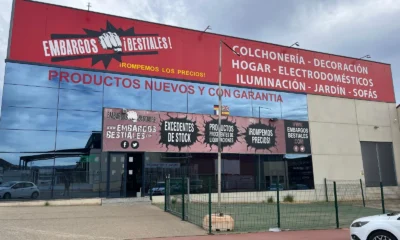Sustainability
Sustainable Projects in Almeria 2025 — Mojacar, El Toyo & Water Initiatives
Published October 16, 2025 | Category: Sustainability
TL;DR: Mojácar begins regeneration and climate adaptation efforts under EU Next Generation funds; Almería’s El Toyo beach gets a sustainable sports complex; Serón launches biomass forest management; and provincial water infrastructure gains major investment. These projects mark a new green era for Almería.
Sustainable Projects in Almería 2025 — From Mojácar to Serón and Beyond
Table of Contents
- Mojácar’s Coastal Regeneration & Climate Adaptation
- El Toyo: A Sustainable Beach Sports Complex for Almería
- Serón’s Biomass Forest Plan: Fire Prevention & Renewable Energy
- Province-Wide Water Infrastructure & Desalination Investments
- Projected Impacts & Community Benefits
- Key Success Factors & Recommendations
- Final Thoughts
Mojácar’s Coastal Regeneration & Climate Adaptation
Mojácar’s town hall has officially initiated a major sustainable transformation plan, laying the groundwork — both literally and figuratively — for its coastal future. The project combines coastal regeneration with climate change adaptation and prevention measures, supported by Next Generation EU funds under Spain’s Recovery, Transformation and Resilience Plan.
The total allocated investment exceeds €1,152,000. The first phase, budgeted at €432,028, focuses on climate adaptation works (natural barriers, shade and permeable surfaces, resilient planting), while the second phase invests €720,000 in waterfront regeneration — landscaping, accessibility and a coherent seaside design that better withstands heat, wind and storm events.
Two priority zones are in scope: the Parque de las Familias / Congo area and the promenade by the Parador zone. The goal is a continuous, inclusive beachfront with ecological sensitivity and public access at its core.
“We have worked on these proposals for years; with European funds we can now transform Mojácar Playa into a modern and sustainable tourism destination,” the mayor has stated. For official updates on municipal works and PSTD actions, see the Ayuntamiento de Mojácar and the national PRTR hub at planderecuperacion.gob.es (NextGenerationEU).
El Toyo: A Sustainable Beach Sports Complex for Almería
In the capital, the city council has unveiled a beach sports complex in the El Toyo coastal zone, a project valued at approximately €1,001,694.83 and financed under the PSTD — Plan de Sostenibilidad Turística en Destino with Next Generation EU funds. The site will sit by the Palacio de Congresos Cabo de Gata – Ciudad de Almería, forming a hub between convention tourism and active, low-impact coastal sport.
Facilities will include beach volleyball, beach football, handball and rugby courts on sand, small stands, improved coastal landscaping, locker rooms and accessible pathways using permeable materials. The municipality positions it as a blue tourism anchor that regenerates public space while attracting year-round events. See the city’s official portal at almeriaciudad.es. For context coverage, the announcement was also carried by Cadena SER.
Serón’s Biomass Forest Plan: Fire Prevention & Renewable Energy
Inland, Serón is scaling up biomass forest management in 2025: a planned harvest of about 1,500 tons of low-value woody material (scrub, thinning residues) to reduce wildfire fuel load while supplying renewable energy. The approach blends fire prevention, habitat health and circular economy: selective removal of underbrush helps native species and creates local energy value chains.
This mirrors Andalusia’s push to integrate forest biomass into district heating and public buildings, where feasible, while prioritising biodiversity. Provincial coordination and municipal notices are typically published through the Diputación de Almería and town-hall channels.
Province-Wide Water Infrastructure & Desalination Investments
Almería’s semi-arid climate makes water security central to sustainability. In 2025, the Spanish Government outlined a package of roughly €586 million in water infrastructure upgrades across the province — desalination capacity, modernised irrigation networks, reservoir works and selective flood-risk mitigation. These actions align national resilience with the province’s agricultural reliance on greenhouse cultivation and with urban demand along the coast.
The logic is straightforward: resilient beaches and promenades must be matched by resilient water systems upstream. Coordinated planning lowers the environmental footprint, stabilises supply and reduces salinity risks for farms. For policy details, consult Spain’s PRTR site (planderecuperacion.gob.es) and the EU programme page (NextGenerationEU).
Projected Impacts & Community Benefits
Taken together, these projects deliver benefits on multiple fronts:
- Economic diversification: Sports and cultural programming in regenerated spaces extends activity beyond peak summer, stabilising local jobs.
- Climate resilience: Dune recovery, shade, permeable pavements and smarter planting reduce heat-island effect and improve storm tolerance.
- Public health & equity: Accessible walkways, safer crossings and barrier-free beachfronts improve everyday life for families, seniors and people with reduced mobility.
- Environmental restoration: Healthier forests and better-managed catchments support biodiversity and reduce catastrophic fire and flood events.
On the ground, Mojácar’s redesign opens segments of promenade that were functionally underused; El Toyo’s complex transforms spare coastal land into an active, inclusive public asset; and Serón’s biomass plan reduces the fuel load threatening forest-edge hamlets.
Key Success Factors & Recommendations
For these initiatives to reach their potential, several principles are essential:
- Joined-up planning: Beach works, water systems and upland ecosystems must be planned together, not in silos.
- Transparent reporting: Publish milestones (budget, timelines, contracts, monitoring) in accessible dashboards to sustain trust.
- Maintenance funding: Allocate multi-year O&M budgets; a great build without upkeep quickly loses impact.
- Local voice: Co-design elements (seating, shade, play, cultural markers) with neighbourhood groups and businesses.
- Replication: Use El Toyo’s specs as a template for Carboneras, Adra, Vera and other coastal towns seeking blue-tourism pivots.
Final Thoughts
Almería’s sustainability story in 2025 is no longer theoretical — it is taking shape in concrete works along the shore, in forests and across water infrastructure. Mojácar is reimagining the promenade with climate in mind; El Toyo is pairing public space regeneration with active tourism; Serón is treating forests as living infrastructure; and the province is aligning with Spain’s PRTR to secure its water future.
What emerges is a province that is not only beautiful but increasingly built for endurance. As these projects move from plans to places, we will keep tracking timelines, budgets and on-the-ground experience — and we’ll spotlight the towns and villages where sustainability becomes part of daily life.
For more on the natural landscapes and environment of Almería, visit our Nature & Environment category.
About the author
KAI is the Sustainability & Regional Development Analyst at VisitingAlmeria.com.
With over 18 years of local insight into Almeria’s evolving economy and environment, KAI explores how the province is transforming through innovation, renewable energy, and community-driven change.
Nature & Environment
Sustainable Oceans: Almeria’s Alboran Sea Protected in Spain’s 2025 Marine Expansion
Published October 19, 2025 | Category: Nature & Environment
TL;DR: Spain has designated a vast 6,277 km² marine protected area off Almeria’s coast. The new “Banks and Gorges of the Alboran Sea” reinforces Natura 2000, safeguards deep-sea coral gardens and seven cetacean species, and pushes Spain toward its 30%-by-2030 ocean-protection goal.
Alboran Sea Marine Protected Area: Spain Expands Ocean Conservation off the Almeria Coast
Table of Contents
- Where Exactly Is the Alboran Sea?
- What’s Protected: Seamounts, Canyons & Cold-Water Corals
- Who Lives Here: Whales, Dolphins, Turtles & Seabirds
- Why This Area Matters: Atlantic–Mediterranean Mixing
- The Legal Backbone: BOE Order, Natura 2000 & INTEMARES
- What Changes Now: Management Plans & Precaution
- Almeria’s Link: Research, Ports & Responsible Tourism
- Threats & Challenges: From Trawling to Warming Seas
- How to Visit Responsibly
- Fast Facts & Timeline
- Final Notes
Where Exactly Is the Alboran Sea?
The Alboran Sea is the westernmost basin of the Mediterranean, stretching between southern Spain and North Africa immediately east of the Strait of Gibraltar. Off Almeria’s coastline, Atlantic inflows meet warmer, saltier Mediterranean waters, creating a dynamic oceanographic “mixing zone” that fuels rich marine life. The newly designated protected site—formally named the Bancos y Cañones del mar de Alborán (Banks and Gorges of the Alboran Sea)—covers 6,277 km² of offshore habitat in this basin. The official order was published in Spain’s Official State Gazette on 7 October 2025.
What’s Protected: Seamounts, Canyons & Cold-Water Corals
At the heart of the designation are submarine mountains, ridges and canyons that rise sharply from the seafloor. These structures create upwellings that bring nutrients toward the surface—hotspots where food webs concentrate. Extensive surveys by Spain’s oceanographic research network describe deep, cold-water coral communities—Lophelia pertusa, Madrepora oculata—and benthic gardens of gorgonians, sponges and deep-sea mollusks thriving on these hard substrates. In plain language: they’re underwater oases, rare and fragile.
Geologically, the Alboran basin is complex and tectonically active. The interaction between seafloor topography and currents helps maintain cooler, oxygen-richer micro-habitats in a warming Mediterranean—one reason scientists pushed for protection here for more than two decades. Spain’s formal listing recognizes these ecological values within the EU Natura 2000 framework, which protects habitats and species of community interest.
Who Lives Here: Whales, Dolphins, Turtles & Seabirds
The new MPA serves as a feeding and migration corridor for at least seven cetacean species: bottlenose (Tursiops truncatus), common (Delphinus delphis), and striped dolphins (Stenella coeruleoalba); Risso’s dolphin (Grampus griseus); short-finned pilot whale (Globicephala melas); fin whale (Balaenoptera physalus); and Cuvier’s beaked whale (Ziphius cavirostris). Loggerhead turtles (Caretta caretta) also traverse this “Alboran corridor,” and pelagic birds use the area as a foraging ground.
Researchers note a spatial pattern: coastal-loving dolphins tend to cluster near shallower seamounts and around Alboran Island, while beaked and pilot whales track deeper isobaths near the 1,000-metre line—exactly the kind of topography safeguarded by the designation. Protecting such gradients is key to conserving the full cast of marine megafauna that make Almeria’s offshore waters unusually vibrant.
Why This Area Matters: Atlantic–Mediterranean Mixing
The Alboran Sea is where Atlantic inflows pulse into the Mediterranean as distinct jets and eddies. These flows—modulated by seafloor ridges and canyons—enhance nutrient availability and primary productivity, which scale up to fish, turtles and whales. In other words, the physics of the place is the biology. Spain’s marine strategy explicitly prioritizes such oceanographic “engines” as anchors of its protected-area network.
There’s a regional storyline here too. Almeria’s coast and ports sit at the doorstep of this offshore engine. From university labs to local tour operators, the mixing of waters offshore ties directly to life onshore—through fisheries, ecotourism and even climate moderation along the coast.
The Legal Backbone: BOE Order, Natura 2000 & INTEMARES
Legally, the Alboran MPA enters Spain’s Natura 2000 network as a Site of Community Importance (SCI) on the road to Special Area of Conservation status. The BOE order of 7 October 2025 details its boundaries, scientific justification and governance triggers. Once the European Commission validates the listing, Spain has up to six years to adopt a site-specific management plan.
The designation dovetails with LIFE INTEMARES, Spain’s EU-funded flagship to reach 30% marine protection by 2030. INTEMARES coordinates science, governance and capacity building nationwide—driven by Fundación Biodiversidad under the Ministry for Ecological Transition (MITECO). Spain’s latest steps added over 17,000 km² of marine protection across five new offshore sites, with the Alboran Banks & Gorges as a lead piece in the western Mediterranean.
What Changes Now: Management Plans & Precaution
Designation is stage one. Next comes a management plan defining conservation objectives, seasonal restrictions, and zoning (no-take cores, research corridors, sustainable-use buffers). Spain typically applies precautionary measures while these plans are drafted: tighter controls on bottom-contact fishing gear over sensitive substrates; limits on underwater noise; and vessel-speed advisories in cetacean zones. The plan will be prepared by national and regional authorities with fishers, scientists and NGOs, using INTEMARES protocols and EU Directives as guardrails.
On the science side, monitoring will rely on IEO-CSIC vessels, passive acoustic arrays, seabed mapping and ROV surveys to check coral health and fishing impacts. Spain’s June 2025 policy note underscores the link between new MPAs and funded monitoring & enforcement—a critical ingredient for turning lines on a map into real conservation gains.
Almeria’s Link: Research, Ports & Responsible Tourism
For Almeria, this is both ocean and identity. Offshore protection feeds back to coastal life through more resilient fisheries, cleaner beaches and a stronger nature brand. It also gives local universities, research centres and coastal operators a clear framework for blue-economy development grounded in conservation.
- Research & Education. The University of Almeria and national institutes can leverage the MPA as a living lab—tracking whales and turtles, testing noise-reduction corridors, and studying how canyon upwellings affect productivity.
- Ports & Circularity. The province is already piloting circular projects linking the sea and low-carbon fuel. See our feature: Plastic to Biodiesel in Almeria.
- Responsible Marine Tourism. Dolphin- and whale-watching trips out of the Port of Almeria can incorporate citizen science and certified codes of conduct, transforming excursions into conservation experiences.
Threats & Challenges: From Trawling to Warming Seas
Cold-water corals are stunningly slow to grow; once damaged by bottom trawls or dumped gear, recovery can take decades to centuries. Beaked whales are highly sensitive to noise; turtles face bycatch risk; and the whole basin is warming and acidifying, altering carbonate chemistry that corals depend on. Effective management must therefore combine gear restrictions, noise mitigation, bycatch reduction and climate resilience—and fund them long-term. Spain’s 2025 agenda emphasizes new protected coverage paired with better tools for surveillance and stakeholder compliance.
Enforcement matters. If trawl tracks, illegal dumping or noisy transits persist over key habitats, the MPA risks becoming a paper park. INTEMARES gives Spain a platform and budget to step up monitoring and co-design solutions with the very communities that depend on the sea.
How to Visit Responsibly
Want to experience Almeria’s deep-blue frontier without leaving a footprint? A few simple choices go a long way:
- Choose accredited operators that follow distance, speed and noise guidelines for whales and dolphins.
- Pack out plastics—and pick up stray litter on beaches; the less that reaches the sea, the better for turtles and corals.
- Keep it quiet on the water: steady speeds, no sudden accelerations, and avoid chasing wildlife.
- Support citizen science: log sightings with the crew; these data help scientists map hotspots.
Fast Facts & Timeline
- Official name: Bancos y Cañones del mar de Alborán (Banks & Gorges of the Alboran Sea)
- Size: 6,277 km² offshore habitat in the Alboran basin
- Wildlife: deep-sea corals (Lophelia, Madrepora), gorgonians, sponges; cetaceans including fin and beaked whales; loggerhead turtles
- Programmes: Natura 2000 (EU Habitats/Birds Directives); LIFE INTEMARES; Spain target ≈ 30% by 2030
- Next steps: EC validation; management plan within six years; precautionary measures in force meanwhile
Final Notes
The Alboran Sea has always been Almeria’s quiet neighbor—vast, blue and mostly out of sight. This new marine protected area brings it into focus. It recognizes an ocean engine where geology stirs currents, currents feed life, and life—in all its whale-and-coral strangeness—anchors a coastal identity. For Spain, it’s a strategic step toward a connected network of well-managed MPAs. For Almeria, it’s an invitation to tell a bigger story: sustainability here doesn’t stop at the shoreline—it reaches deep beneath the surface.
For official background and ongoing updates, see Spain’s MITECO brief, the BOE Order (7 Oct 2025), the LIFE INTEMARES programme via Fundación Biodiversidad, and the IEO-CSIC for scientific updates.
About the author
KAI is the Sustainability & Regional Development Analyst at VisitingAlmeria.com.
With over 18 years of local insight into Almeria’s evolving economy and environment, KAI explores how the province is transforming through innovation, renewable energy, and community-driven change.
For more updates from across the province, visit our Nature & Environment category.
Sustainability
Sustainable Almeria 2025: A Bold Vision for a Greener Future
Published October 18, 2025 | Category: Sustainability · Nature & Environment
TL;DR: In Europe’s driest corner, sustainable Almeria is no slogan but a lived reality. Solar fields, desalinated water, circular farming and protected landscapes are turning scarcity into a strategy for resilience. This longread explores the people, places and projects redefining the province’s future.
Sustainable Almeria 2025: A Bold Vision for a Greener Future
From a distance, Almeria looks like a province drawn in light: pale desert, hard sky, a coastline chiselled by wind. For decades, the story here was drought and departure. Today, that narrative is being rewritten. Under the banner of sustainable Almeria, engineers, growers, town councils and nature wardens are stitching together a new model of life in a changing climate. It is neither utopian nor glossy; it is practical, incremental, and quietly ambitious.
The Desert Paradox
Almeria is Spain’s sunniest province, but also one of its most water-stressed. That tension—abundance of light, scarcity of rain—has become the province’s competitive edge. Photovoltaic parks hum across the interior; concentrated solar research advances in the Tabernas Desert at the Plataforma Solar de Almeria; and on the coast, communities are pairing visitor comfort with conservation. The skeleton of sustainable Almeria is simple: produce clean energy, protect water, farm smarter, and keep nature intact while people thrive.
Water: The Invisible Backbone
Water makes or breaks life in Almeria. Over the past two decades, a string of measures has shifted the equation. Modern desalination plants feed municipal networks; treated water is recovered for agriculture; leaky pipes and open channels are being replaced with pressure-managed distribution. In the city of Almeria, the integrated water cycle program ties supply, reuse and stormwater capture into a single, smarter system—less waste, more resilience in heatwaves and flash-rain episodes.
In the east of the province, new interconnections secure drought buffers by moving desalinated volumes where they are needed most. Farmers, meanwhile, lean on drip irrigation, soil-moisture sensing and shaded cultivation. The result is a pattern that defines sustainable Almeria: use just enough, recycle what you can, and design every drop into the landscape.
Energy From Light
Drive the Filabres or the open plateau near Tabernas and you’ll see it: a horizon of mirrors, trackers and panels, all pointed at the sun. The Plataforma Solar de Almeria helps test the technologies that move the grid toward storage and stability, while utility-scale PV plants deliver clean electrons at a scale unimaginable a generation ago. But the transition is not only industrial. Small towns install rooftop arrays on schools and civic buildings; rural guesthouses run mini-microgrids; EV chargers appear in places that once felt off-grid. This is how sustainable Almeria takes shape at ground level—quiet upgrades that add up.
From Plastic Sea to Circular Farming
The coastal plain of Campo de Dalías—often dubbed the “Mar de Plástico” for its sea of greenhouses—has long divided opinion. Yet the most interesting story is no longer the plastic itself, but what replaces and circles through it. Growers are trialling biodegradable films, re-circulating irrigation, recovering nutrients from drainage and, in some cases, capturing CO₂ to nudge photosynthesis. Co-ops experiment with regenerative rotations and on-site composting. Supported by the Ministry of Agriculture (MAPA), these initiatives are part of Spain’s largest pilot for regenerative agriculture. The aim is not to romanticise the greenhouses, but to bend them toward a lower-impact future that fits the logic of sustainable Almeria.
Almeria’s shift toward circular innovation is already visible in other pioneering initiatives. One standout example is the Plastic to Biodiesel project in Almeria, where port waste and marine plastics are being transformed into clean fuel. Together, these efforts highlight how the province is evolving into one of southern Spain’s most dynamic sustainability hubs.
Nature, Wetlands and Fire-Wise Landscapes
Beyond fields and panels, the province’s wild heart still beats. The Albufera de Adra wetlands host migratory birds in two brackish lagoons framed by reeds and salt-tolerant shrubs. In the Cabo de Gata-Níjar Natural Park, dunes, salinas and volcanic coves draw visitors under a regime that sets carrying capacities and prioritises fragile habitats. Inland, oak and pine mosaics in the Sierra de los Filabres are managed with fire in mind—thinning, biomass use, and the slow return of native understory to break fuel continuity. Much of the environmental monitoring and data transparency is coordinated through the Andalusian Environmental Information Network (REDIAM).
These efforts are less headline-grabbing than a new solar tower, but they anchor the identity of sustainable Almeria: a place where conservation isn’t a brochure term; it’s logistics, ranger shifts, and a thousand small decisions about where feet and tyres should not go.
People First: Towns, Trails and Local Life
Resilience is built by people. In whitewashed villages from Laujar to Lucainena, residents restore acequias to move mountain water gently across terraces. In Níjar and Mojácar, businesses reduce waste, switch lights, and source local produce. Guides map quiet trails for shoulder-season hiking; astronomy groups treat dark skies as a resource to be protected. None of this feels like marketing. It feels like home—a lived version of sustainable Almeria in which modest changes accumulate into cultural shift.
Education and Knowledge
At the University of Almeria, students and researchers track desertification, test plant stress tolerance, and model coastal change. Partnerships with public agencies and labs fast-track field trials into municipal policy. School programmes teach water literacy and habitat etiquette; citizen-science counts flamingos and nightjars. This knowledge loop—observe, test, apply—keeps sustainable Almeria grounded in evidence rather than rhetoric.
Travel Lighter, See More
Visitors can join the story without leaving heavy footprints. Plan hikes at dawn or late afternoon, carry water, and stay on marked routes in sensitive areas like wetlands and dunes. Choose family-run stays that source locally; swap one car day for a cluster of city errands and then a beach day by bus. Respect seasonal closures. Leave no trace beyond footprints—and even those, if the sign asks you to keep to the boardwalk.
Policy, Plans and the Long View
Strategies only matter if they survive election cycles and budget years. In Almeria, multi-year plans tie funding to outcomes: water security through reuse and interconnections; energy through large and small renewables; agriculture through efficiency and circularity; and nature through restoration and strict visitor management. The longer the horizon, the steadier the hand. That is how sustainable Almeria moves from pilot to pattern.
2030: Milestones That Matter
- Energy: expand renewables across public buildings and local grids; normalise EV charging in towns and trailheads.
- Water: scale reuse and reduce losses; ensure drought buffers via desalinated interlinks; protect aquifers.
- Agriculture: widen regenerative trials; cut plastic waste; push toward zero-waste handling of crop residues.
- Nature: maintain carrying capacities in parks; restore wetlands and riparian strips; manage biomass for fire risk.
- Community: embed sustainability in schools, tourism training and town budgets; celebrate stewardship.
Setbacks, Trade-offs and Honesty
There are no perfect solutions. Desalination demands energy and careful brine handling; solar parks change landscapes; tourism must be channelled to avoid loving fragile places to death. The point is not purity but proportion. Sustainable Almeria works when projects are sized to context, when benefits reach towns as well as cities, and when data—not slogans—decide what scales up and what stops.
A Province Reimagined
At sunset, the Tabernas light turns copper and the wind eases. Panels slowly track the last angle of the sun; out at the wetlands, stilts pick their way through mirror-calm water. In the villages, shutters open to the evening air. “We live with the desert,” a farmer in Níjar said. “It teaches patience. We don’t fight the place; we learn its rules.”
That is the quiet thesis of sustainable Almeria: live by the logic of place. Use what is abundant, guard what is scarce, and let the landscape—not the brochure—set the terms. Done well, resilience looks ordinary. That’s the point.
For more on local projects and practical ways to travel lighter, explore our Sustainability hub and related guides in Nature & Environment.
About the author
KAI is the Sustainability & Regional Development Analyst at VisitingAlmeria.com.
With over 18 years of local insight into Almeria’s evolving economy and environment, KAI explores how the province is transforming through innovation, renewable energy, and community-driven change.
Sustainability
Sustainable Projects in Almería.
Published May 28, 2025 | Category: Sustainability
Almería is no longer just Spain’s greenhouse capital — it is now a reference point for sustainable projects in Almería and across southern Europe.
Sustainable Projects in Almería: 6 Bold Plans Shaping a Greener Future
- 1. New €20.5M Recycling Facility
- 2. Toblerone Silo Urban Park
- 3. Mina de la Solana Restoration
- 4. Sustainable Greenhouse Agriculture
- 5. University of Almería Carbon Plan
- 6. Smart City & ICC Program
1. New €20.5M Recycling Facility: Circular Economy in Action
Set to open in 2025, Almería’s new recycling facility represents a €20.5 million investment in circular economy infrastructure. The plant will use cutting-edge sorting and processing technologies to transform waste into reusable materials, cutting landfill dependency and lowering the province’s carbon output. It’s expected to serve as a regional model of high-capacity, low-impact waste management.
More details (Spanish): Junta de Andalucía
2. Toblerone Silo Urban Park: Green Space from Industrial Ruin
The abandoned Toblerone Silo, once used for iron ore storage, is undergoing a remarkable transformation. Almería is turning this iconic structure and its surrounding zone into a sprawling green urban park. This project enhances biodiversity, provides valuable leisure space, and preserves an important piece of local history—an example of sustainable urban regeneration at its best.
3. Mina de la Solana Restoration: Healing the Sierra de Gádor
In Almócita, the historic Mina de la Solana mining site is receiving €1.7 million in funding for ecological rehabilitation. The Andalusian regional government is leading efforts to stabilize the terrain, replant native flora, and reduce the visual and environmental impact of former mining operations. The site is also expected to host nature trails and serve as a pilot for landscape restoration throughout the Sierra de Gádor.
4. Sustainable Agriculture in Almería’s Greenhouses
Known as the “Garden of Europe”, Almería’s massive sea of greenhouses is going green. Farmers are adopting sustainable practices such as:
- Precision irrigation and rainwater reuse
- Biodegradable mulching materials
- Solar-powered operations
- Integrated pest management
These sustainable projects in Almería are reducing environmental impact while keeping the region at the forefront of Europe’s fruit and vegetable production. The greenhouse sector is also experimenting with reflective materials that reduce land temperature and fight local climate warming.
5. University of Almería: Leading by Example
The University of Almería has committed to reducing its carbon footprint by 30% in coming years. Its campus-wide sustainability plan includes building retrofits, solar installations, e-bike infrastructure, and educational programs on climate action. The university is positioning itself as a knowledge hub for green transformation and community involvement in sustainable policy.
6. Smart City Innovation: Almería in the ICC Program
Almería is one of the Spanish cities selected for the European Commission’s Intelligent Cities Challenge (ICC). Under this initiative, the city is advancing its digital infrastructure to support:
- Smart mobility and public transport
- Energy-efficient street lighting and buildings
- Citizen engagement through open data dashboards
The ICC program places Almería in an elite group of cities building sustainable futures through integrated urban planning, digital services, and environmental tech.
Almería’s Sustainability Map: A Connected Future
These six projects don’t stand alone. They’re part of a broader regional transformation where environmental goals, public innovation, and smart governance intersect. The synergy between port digitization (Smart Port Almería), green urban renewal, and eco-agriculture is positioning Almería as a testbed for Mediterranean sustainability.
Conclusion
From mountains to greenhouses, from the port to the university, Almería is redefining what a sustainable province looks like. These projects show that with the right vision and investment, even historically industrial or agricultural regions can lead the green transition.
For more on the sustainable transformation in Almería, visit our Sustainability section.
Looking for broader coverage? More Almería news
Sustainability
Port of Almería: How AI Is Transforming the Future of Green Port Operations
Published May 28, 2025 | Category: Sustainability
The Port of Almería is becoming one of Spain’s smartest maritime hubs, thanks to a cutting-edge AI project that optimizes operations and reduces environmental impact.
Smart Port Almería: How AI Is Transforming the Future of Green Port Operations
- What is ACOPIAIA – Puertos 4.0?
- Sensors, Cameras and AI Infrastructure
- Operational and Environmental Outcomes
- Collaboration, Scaling and the Future
- Conclusion
What is ACOPIAIA – Puertos 4.0?
The ACOPIAIA project, short for “Algoritmia para la Caracterización, Optimización y Predicción del Impacto Ambiental basada en Inteligencia Artificial en Puertos 4.0,” is an ambitious AI-driven initiative launched at the Port of Almería. Developed in collaboration with the Universidad Politécnica de Madrid and tech firm Aptica, it aims to make the port smarter, greener, and more resilient.
Funded by Spain’s public innovation agency Red.es, ACOPIAIA forms part of the national ‘Puertos 4.0’ framework—a strategy to digitally transform Spanish ports by implementing artificial intelligence, real-time analytics, and sustainable practices.
Sensors, Cameras and AI Infrastructure
Over an 18-month period, the Port of Almería was equipped with a vast network of digital tools to collect and process real-time environmental data:
- 7 Environmental Sensors – measuring air quality (CO, NO₂, SO₂, O₃), particulate matter (PM₁, PM₂.₅, PM₁₀), temperature and humidity.
- 4 Sound Meters – tracking port-related noise pollution and traffic noise from nearby roads.
- 5 AI-Enabled Cameras – monitoring traffic flow, vehicle activity and material handling in bulk storage zones.
The data gathered is continuously fed into AI models that detect patterns, predict future pollution scenarios, and recommend operational adjustments—often in real time.
Operational and Environmental Outcomes
Meeting Air Quality Standards
Analysis of the collected data revealed that the Port of Almería consistently meets national and EU air quality regulations. Contrary to concerns, the handling of dry bulk cargo was not a significant contributor to airborne particulate pollution, thanks to strict protocols like misting, wind barriers, and wheel washing systems.
Smart Response to Weather and Emissions
The AI engine allows the port to anticipate pollution spikes triggered by specific meteorological conditions—such as thermal inversions or heavy wind events—and adapt operations accordingly. For example, high-polluting activities can be rescheduled, rerouted, or temporarily suspended.
Noise Detection and Mitigation
ACOPIAIA also enabled port authorities to pinpoint unexpected sources of noise pollution and redesign workflows to minimize impact on surrounding residential areas. This includes an intelligent warning system that triggers alerts when sound thresholds are exceeded.
Optimizing Logistics
Operationally, AI-generated insights now help dispatch teams to allocate vehicles and schedule cargo movements more efficiently. This reduces traffic congestion inside the port and cuts down idle emissions from waiting trucks.
Collaboration, Scaling and the Future
One of ACOPIAIA’s core strengths is its collaborative nature. The partnership between public institutions and private tech has created a scalable framework that could be applied to other Mediterranean ports.
Plans are underway to develop:
- A real-time emissions dashboard shared with the municipality of Almería.
- Urban sound modeling to assess the port’s acoustic footprint in residential neighborhoods.
- A public-facing information portal for citizens to track environmental indicators.
The success of ACOPIAIA in Almería showcases how medium-sized ports can become innovation labs for sustainable logistics, even without the massive budgets of larger container terminals like Barcelona or Valencia. ACOPIAIA is one of several digital transformation efforts supported under the national Puertos del Estado strategy to make Spanish ports more sustainable and competitive.
Not just about faster operations
Almería is proving that a smart port is not just about faster operations—it’s about better ones. With AI as a strategic tool, the port is reducing its environmental footprint while improving logistics, safety and transparency.
In a world where ports are under increasing pressure to modernize and decarbonize, the ACOPIAIA project offers a replicable model of smart, scalable and sustainable maritime innovation.
For more insights into regional sustainability innovation, visit our Sustainability catern.
Looking for broader coverage? More Almería news
-

 Infrastructure6 days ago
Infrastructure6 days agoMurcia–Almería High-Speed Rail: €9.6 Million in New Funding
-

 Events6 days ago
Events6 days agoMojácar Christmas 2025: Disney Day & Official Lights Switch-On
-

 Events5 days ago
Events5 days agoTerreros Slalom 2025: 35 Drivers Compete in a Key Andalusian Championship Round
-

 Community5 days ago
Community5 days agoDisney in Almeria: The Forgotten Story of the Park That Almost Happened
-

 Expats & Living6 days ago
Expats & Living6 days agoEmbargos Bestiales Antas – Affordable Furniture and Home Goods in Almería
-

 Towns & Villages1 day ago
Towns & Villages1 day agoVera Nativity Scene 2025: A Monumental Journey to Ancient Rome















